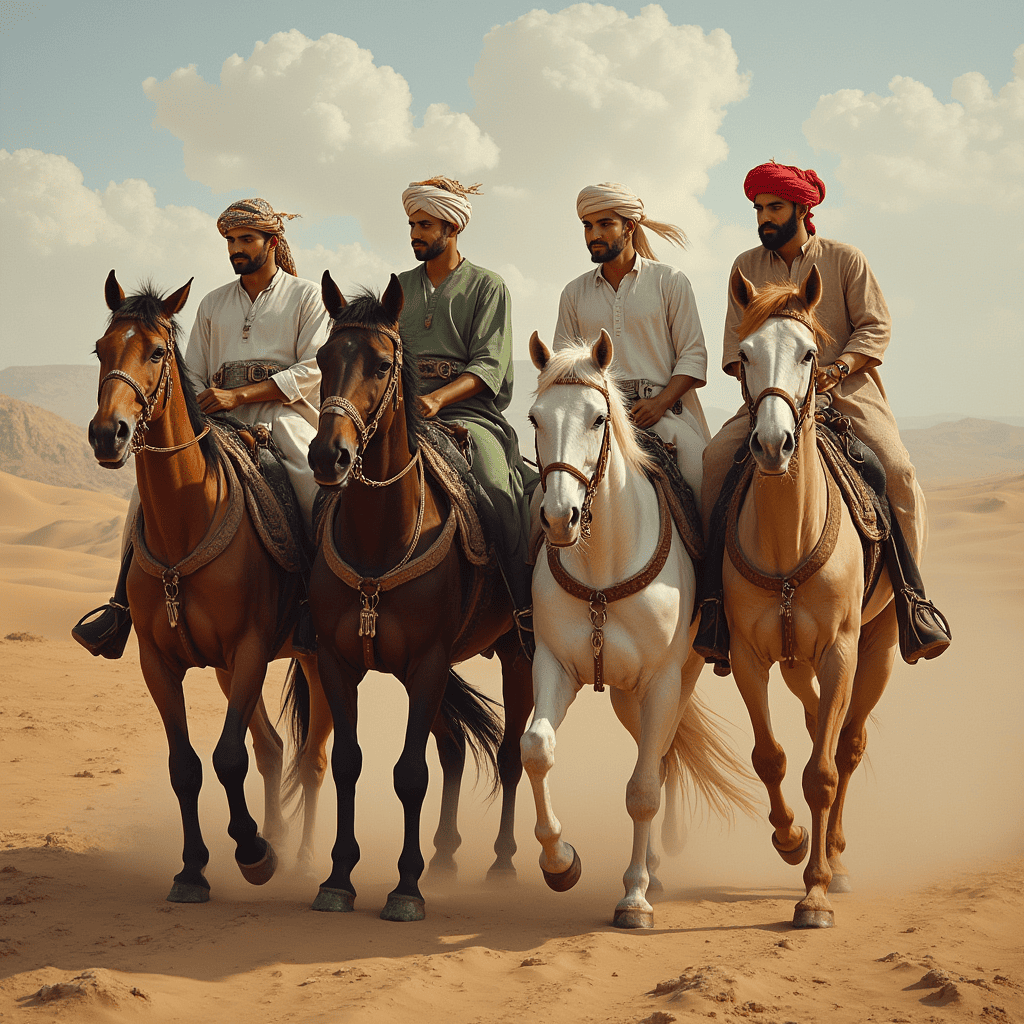For centuries, horses have held a place of unmatched reverence in Arab culture, symbolizing strength, nobility, and endurance. Among the world’s most esteemed equine breeds, the Arabian horse stands apart—not just for its striking beauty, but for its deep-rooted connection to the identity and heritage of the Arab people. These majestic creatures were more than mere animals to the Bedouin tribes; they were cherished companions in the harsh desert, vital for survival, warfare, and even poetry. Their legacy is woven into the very fabric of Arab history, shaping traditions that endure to this day.
From the windswept dunes of the Arabian Peninsula to the glittering stables of modern-day Dubai, the bond between Arabs and their horses has remained unbroken. The Arabian horse is celebrated not only for its speed and stamina but also for its loyalty and intelligence, traits that made it indispensable in ancient battles and a prized possession among kings and warriors. Today, this legacy lives on through equestrian festivals, royal stables, and global breeding programs, ensuring that the spirit of these legendary horses continues to inspire. In this blog post, we’ll explore the history, cultural significance, and enduring legacy of horses among the Arabs—unveiling why they remain a timeless symbol of pride.
The Historical Significance of Horses Among the Arabs
Horses in Ancient Arabia
Role in Bedouin Life (Survival, Transportation, Warfare)
For the nomadic Bedouin tribes, horses were not merely animals—they were lifelines in the harsh desert. Unlike camels, which carried heavy loads, Arabian horses were prized for their speed, agility, and endurance, making them ideal for raiding, warfare, and swift travel. The Bedouins treated their horses as family, often bringing them into their tents for protection from extreme weather and thieves. A famous Bedouin saying goes: “The horse is a gift from God, and the Arab is the guardian of this gift.”
Mentions in Pre-Islamic Poetry and Early Arab Culture
Long before Islam, Arabian horses were immortalized in classic pre-Islamic (Jahiliyyah) poetry, where they symbolized bravery, loyalty, and tribal honor. Legendary poets like Antara ibn Shaddad praised their steeds in epic verses, comparing their swiftness to the desert winds. The Mu’allaqat (Hanging Poems)—some of the most revered Arabic poetry—frequently depicted horses as noble companions in battle and desert life.
H3: The Role of Horses in Islamic History
Prophet Muhammad’s Love for Horses
Islam further elevated the status of horses, with the Prophet Muhammad (PBUH) emphasizing their importance. He reportedly said: “Goodness is tied to the forelocks of horses until the Day of Judgment.” His own mare, Al-Buraq, is celebrated in Islamic tradition as the heavenly steed that carried him during the Isra and Mi’raj (Night Journey). The Prophet also encouraged horse racing (Sabaq) and charitable endowments (Waqf) for their upkeep.
Horses in Islamic Conquests and Their Symbolic Importance
Arabian horses played a pivotal role in the rapid expansion of the Islamic Caliphates. Their stamina and agility allowed Muslim armies to cover vast distances, from the Persian Empire to Spain. The Mamluk warriors, elite cavalrymen of the Islamic world, relied on Arabian steeds for their unmatched battle prowess. Even today, many Islamic dynasties (like the Saudis and Jordanian royals) maintain prestigious stables as a continuation of this legacy.
The Arabian Horse in Global History
How Arabian Horses Influenced European Breeds
The crusades (11th–13th centuries) introduced Europeans to the superiority of Arabian horses, leading to crossbreeding that produced Thoroughbreds, Andalusians, and Lipizzaners. Napoleon’s famed warhorse, Marengo, was of Arabian descent, showcasing their endurance in battle. Even the English Royal Family imported Arabian stallions to refine their cavalry.
Famous Historical Figures Who Prized Arabian Horses
- Genghis Khan & the Mongols – Used Arabian hybrids for their conquests.
- George Washington – Owned an Arabian named “Magnolia.”
- Wilhelm II of Germany – Established a breeding program for Arabian horses.
The Cultural and Symbolic Importance of Arabian Horses
Horses in Arab Traditions and Celebrations
Equestrian Festivals & Competitions (e.g., Dubai World Cup)
Modern Arabia celebrates its equestrian heritage through lavish events like:
- Dubai World Cup – The world’s richest horse race.
- King Abdulaziz Horse Festival (Saudi Arabia) – Showcasing purebred Arabian lines.
- Traditional “Ardah” dances – Where horses perform synchronized movements.
Horses in Weddings, Poetry & Tribal Pride
In Bedouin weddings, a groom arriving on a decorated Arabian horse symbolizes nobility and status. Horses also remain central to Nabati poetry, where they are metaphors for freedom and courage. Tribes like the Shammar and Anizzah still take immense pride in their heritage bloodlines.
The Arabian Horse in Art & Literature
Depictions in Classical Arabic Poetry
From Al-Mutanabbi’s odes to Imru’ al-Qais’ elegies, Arabian horses are romanticized as celestial beings. The “Horse Ode” (Qasidat al-Faras) by Abu Tamam remains a masterpiece.
Modern Media & Films Featuring Arabian Horses
- “Hidalgo” (2004) – Based on a true story of an Arabian stallion in a long-distance race.
- “The Black Stallion” (1979) – Showcases the beauty of Arabian horses.
- Saudi & UAE cultural films – Often feature horses in historical epics.

The Unique Traits of Arabian Horses
Physical Characteristics
Distinctive Features (Dished Face, Arched Neck, High Tail Carriage)
The Arabian horse is instantly recognizable by its elegant and refined appearance, shaped by centuries of desert adaptation. Its most striking feature is the dished (concave) profile of its face, a trait rarely found in other breeds. Combined with large, expressive eyes, wide nostrils for efficient breathing, and a short, arched neck, the Arabian exudes nobility. Another hallmark is its high tail carriage, often raised like a banner when in motion—a feature celebrated in ancient Arab poetry.
Beyond beauty, these traits serve practical purposes:
- The dished face allows for greater sinus capacity, aiding in cooling hot desert air before it reaches the lungs.
- A compact body (typically 14.1–15.1 hands) and strong bone density enhance agility and endurance.
- Short, strong backs (with one fewer lumbar vertebra than other breeds) contribute to their legendary stamina.
Stamina and Adaptability to Harsh Desert Climates
Arabian horses evolved in the extreme conditions of the Arabian Peninsula, where they survived on minimal food and water. Their efficient metabolism allows them to thrive in scorching heat, while their light yet muscular build enables them to travel long distances without tiring. Bedouins selectively bred these traits, resulting in a horse capable of crossing vast deserts while carrying riders or goods. Even today, Arabians dominate endurance racing, where races span 50–100 miles in a single day—proof of their unmatched stamina.
Temperament and Intelligence
Loyalty and Strong Bond with Humans
Unlike many horse breeds, Arabians are known for forming deep emotional connections with their owners. Bedouins believed their horses were “gifts from Allah” and treated them as family, often sharing food and shelter with them. This close relationship fostered a breed that is:
- Highly attuned to human emotions – Quick to respond to subtle cues.
- Eager to please – Making them easier to train than more independent breeds.
- Protective – There are accounts of Arabian horses refusing to leave wounded owners in battle.
Why They Excel in Endurance Racing and Dressage
- Endurance Racing: Their natural stamina, heat tolerance, and mental resilience make them unbeatable in long-distance races. The Tevis Cup and Dubai Crown Prince Endurance Ride frequently feature Arabian winners.
- Dressage: Despite their smaller size, Arabians are agile and graceful, performing intricate movements with precision. Their intelligence and willingness to learn make them ideal for high-level competition.
Breeding and Preservation of Arabian Horses
Traditional Bedouin Breeding Practices
Selective Breeding for Purity and Performance
The Bedouins were among the first to practice systematic selective breeding, prioritizing:
- Purity of bloodline (Asil) – Only the strongest, most loyal horses were allowed to reproduce.
- Proven performance – Horses were tested in long desert journeys and raids before breeding.
- Oral pedigrees (Dhabihah) – Lineages were memorized and recited, as written records were rare.
Famous Bloodlines (e.g., Al Khamsa, Straight Egyptian)
- Al Khamsa (“The Five”) – Refers to the five legendary mares believed to be gifted by Allah to the Bedouins.
- Straight Egyptian – Descendants of horses bred by Egyptian royalty, known for extreme refinement.
- Polish & Russian Arabians – Developed from desert-bred imports, now prized for athleticism and beauty.
Modern Arabian Horse Breeding
Leading Stud Farms in the Middle East (Saudi Arabia, UAE, Qatar)
- Janadriyah Stud (Saudi Arabia) – Owned by the Saudi royal family, home to champion endurance horses.
- Al Shaqab (Qatar) – A state-of-the-art facility preserving Straight Egyptian and Desert-Bred lines.
- Dubai Arabian Horse Stud (UAE) – Founded by Sheikh Mohammed bin Rashid Al Maktoum, breeding world-class racehorses.
The Role of DNA Testing in Preserving Bloodlines
- Genetic mapping ensures no crossbreeding dilutes ancient lineages.
- Microchipping tracks pedigrees, preventing fraud in sales and competitions.
- Global databases (like WAHO) certify purebred Arabians worldwide.

The Legacy of Arabian Horses Today
Arabian Horses in Competitive Sports
Dominance in Endurance Racing and Show Jumping
- Endurance: Arabians hold 90% of top finishes in races like the World Equestrian Games.
- Show Jumping: While not as tall as Warmbloods, Arabians like “Cass Ole” (the “Black Stallion” movie star) proved their jumping prowess.
Famous Arabian Racehorses and Their Achievements
- Marwan Al Shaqab – The most expensive Arabian sire, with offspring selling for millions.
- WH Justice – A legendary show horse, undefeated in U.S. championships.
Conservation and Global Influence
Efforts to Protect Purebred Arabian Horses
- Desert Heritage Museums (like Dubai’s Al Marmoom) document Bedouin horsemanship.
- UNESCO Recognition – Campaigns to list Arabian horse culture as Intangible Cultural Heritage.
How Arabian Horses Continue to Inspire Equestrian Culture Worldwide
- Hollywood & Art – From “Lawrence of Arabia” to modern equine photography.
- Symbol of Prestige – Owned by celebrities like Oprah Winfrey and Roger Moore.
Conclusion
The Arabian horse is far more than a majestic breed—it is a living testament to the enduring spirit, heritage, and ingenuity of Arab culture. From the windswept deserts where Bedouins first forged an unbreakable bond with these noble creatures, to the modern arenas where they continue to dominate endurance racing and captivate global audiences, Arabian horses embody resilience, beauty, and an unparalleled connection to humanity. Their influence stretches across continents, shaping equestrian history, art, and even warfare, while their bloodlines remain fiercely guarded as a priceless legacy. Today, as breeders employ cutting-edge science to preserve their purity and enthusiasts celebrate their grace in competitions and cultural events, the Arabian horse stands as a timeless symbol of pride—not just for the Arab world, but for all who recognize its extraordinary place in history. To witness an Arabian horse in motion is to witness centuries of tradition galloping into the future, a reminder that some bonds between humans and animals are truly eternal.

